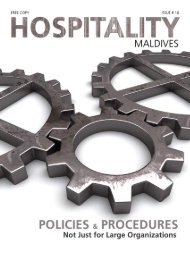Untitled - Hospitality Maldives
Untitled - Hospitality Maldives
Untitled - Hospitality Maldives
Create successful ePaper yourself
Turn your PDF publications into a flip-book with our unique Google optimized e-Paper software.
Receiving:<br />
Check It, Before You<br />
Accept It<br />
The beginning of every great meal begins<br />
with the purchasing and receiving of the<br />
freshest products available. Careful selection<br />
of your suppliers is the first step in ensuring<br />
you receive these fresh products. Question<br />
your suppliers to ensure that they have established<br />
food safety practices in place. You<br />
should only buy from suppliers who are getting<br />
their products from licensed reputable<br />
manufacturers who adhere to all applicable<br />
health regulations. Suppliers should meet the<br />
following criteria:<br />
• use a HACCP (Hazard Analysis Critical<br />
Control Point) system in their operations<br />
• train all employees in sanitation<br />
• use clean delivery trucks with proper<br />
refrigeration<br />
• package foods in leak proof, protective,<br />
durable packaging<br />
• should meet federal and state health<br />
standards<br />
You should let vendors know what you expect<br />
from them by putting safety standards<br />
in your purchase specification agreement and<br />
note any deficiencies for further review.<br />
Once your establishment has set up a relationship<br />
with a supplier, be a smart customer.<br />
Always inspect deliveries. Don’t take anything<br />
for granted. Even though federal and<br />
state agencies regulate and monitor the production<br />
and transportation of food such as<br />
meat, poultry, seafood, eggs dairy products,<br />
and canned goods, it is your responsibility<br />
to check the quality and safety of food that<br />
comes into your establishment. Remember<br />
that receiving is the first step where you can<br />
control the safety and quality of the food in<br />
your restaurant.<br />
Make sure that you are prepared for your<br />
shipment. Have clean handtrucks, carts or<br />
dollies, and containers available in the receiving<br />
area. Make sure you have enough space<br />
in your storage areas prior to receiving a<br />
shipment. If possible receive only one delivery<br />
at a time. Inspect and store each delivery<br />
before accepting another one to avoid product<br />
abuse in the receiving area. If deliveries<br />
arrive at a time that is not convenient ask the<br />
supplier to come back at another time that<br />
is. Schedule shipments so they arrive at the<br />
non-peak times of the day. That way you can<br />
ensure that your crew can check to see that<br />
the food arrives in good condition.<br />
Employees assigned to receive deliveries<br />
should be trained to inspect food properly, as<br />
well as to distinguish between products that<br />
are acceptable and those that are not. They<br />
should be authorized to reject products that<br />
are not acceptable.<br />
Take sample temperatures of all refrigerated<br />
and frozen foods as well as the delivery<br />
truck. Use a clean, calibrated thermometer<br />
to check the products. All products – especially<br />
meat, poultry, and fish – should be<br />
checked for proper color, texture, and odor.<br />
Live molluscan shellfish and crustacea must<br />
be delivered alive. Eggs should be checked<br />
for freshness and be checked for cleanliness<br />
and cracked shells. Dairy products must be<br />
checked for freshness. Produce should be<br />
fresh and wholesome.<br />
Make sure delivery trucks look and smell<br />
clean and are equipped with proper storage<br />
equipment. Ensure that the refrigerated<br />
products are at the proper temperature of<br />
41 degrees Fahrenheit or below. Make sure<br />
frozen foods are in air-tight, moisture-proof<br />
packaging. Broken boxes, leaky packages, or<br />
dented cans may be signs of mishandling and<br />
could be grounds for rejecting the shipment.<br />
Check packaging for signs of re-freezing, prewetness,<br />
and pest infestation. Just because a<br />
product is dry or frozen upon receipt does<br />
not mean it was not wet or had not thawed<br />
during prior handling.<br />
Label all items before storage with the delivery<br />
date or the use-by date to ensure proper<br />
food rotation. Put products away as soon as<br />
possible, especially frozen food or foods that<br />
require refrigeration. Keep the receiving area<br />
clean and well lit to discourage pests.<br />
It is your establishment’s right to refuse an<br />
unacceptable delivery. If the product does<br />
not adhere to these criteria when it arrives,<br />
you have every right to refuse the shipment.<br />
Having established procedures for inspecting<br />
products can reduce hazards before they enter<br />
your establishment.<br />
Adapted with permission from ServSafe Essentials - Second Edition, ©2002 by the National Restaurant Association Educational Foundation.<br />
ServSafe is a registered trademark of the National Restaurant Association Educational Foundation. This article is reprinted with permission by Daydots 2008.
















